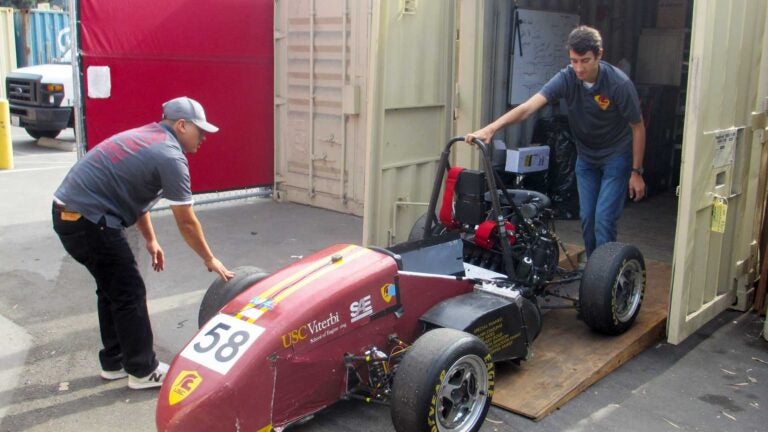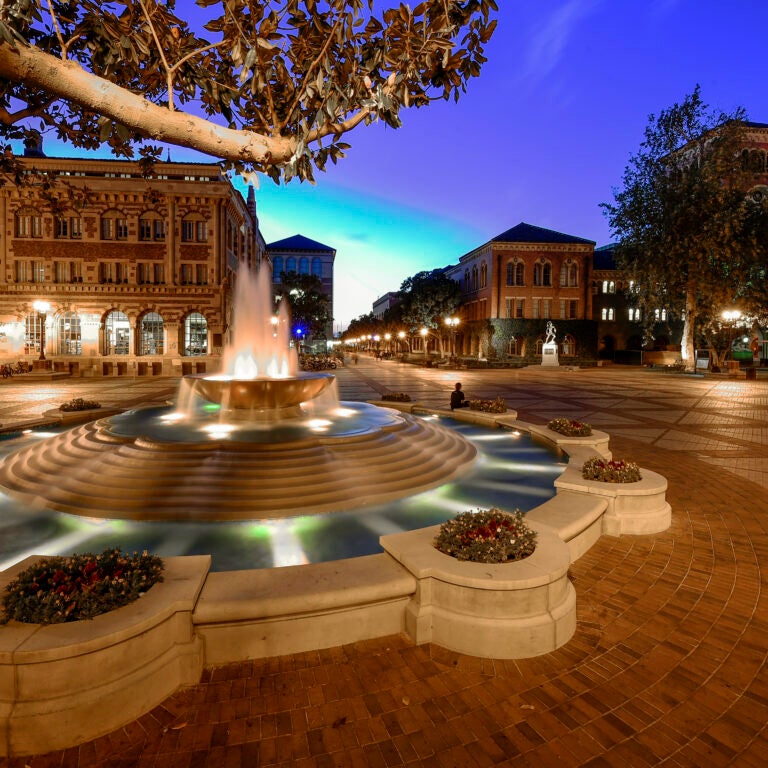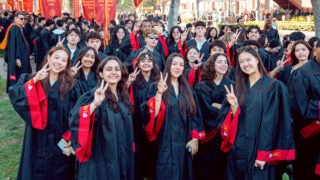
USC Racing team captains Kenny Barrera and Luke Sanasarian prep one of their cars. (Photo/Ashleen Knutsen)
Viterbi-led USC Racing team lays out plans for glory on the track
Meet USC Racing’s team captains: A Q&A with the undergraduate students who run the Trojan Formula SAE racing team
The auto-racing world extends far beyond NASCAR and the Indycar circuit, and USC students are making their mark in a student-focused competition known as Formula SAE.
Each year, SAE (the former Society of Automotive Engineers) invites student teams to design, build and test a formula-style, single-seat race car and compete in a variety of static and dynamic events. USC Racing achieved a major milestone by completing all events at the annual competition and in the top third of the 73 teams competing in 2017. Team captains Luke Sanasarian and Kenny Barrera, both mechanical engineering majors at the USC Viterbi School of Engineering, discuss their experience on the team and this year’s competition efforts.
Are you both racing fans?
Luke Sanasarian: In high school, I got really into cars and that’s kind of why I chose to major in mechanical engineering. I was getting into Formula 1 right around the time that I was looking for colleges, so this team seemed perfect for me. It was actually one of the reasons why I came to USC.
Kenny Barrera: I’ve always liked cars. I grew up around a mechanic [his father] and I was always interested in learning how to actually fix and work on a car. I think the biggest thing I took away from the racing team was the knowledge and being able to transfer that same knowledge over to an actual car.
When you first joined the team, were you surprised at what goes into building a car?
Sanasarian: I’m not surprised at how much work goes into it, but I was surprised at how much design work is actually done by the students. I expected it to be kind of a cookie-cutter thing where the rules tell you how to build a car and then you build it and take it to competition for fun. But really, Formula SAE gives you a box to build a car inside of and they let you run wild within those rules. Ninety percent of the car is parts designed by students and built by students and put together. The fact that it’s even able to go by the end of the day is surprising to me.
Barrera: I was just always amazed at the end product and just knowing how deeply each component interacts with each other. For example, how much power train depends on the electronics and how the whole vehicle itself depends on the aerodynamics. It’s just insane. I never thought I’d be involved with something like that. Seeing a regular commercial car, you think it must be easy making all these things come together, but when you get down to the core of it and you start really trying to understand, it blows your mind. How does this happen within one year?
Did you need to know anything about cars to join?
Sanasarian: With newer members coming in, we don’t expect you to have any knowledge about how any of this works or even any engineering knowledge. When you’re a sub-team lead or when you’re in our position, you try to teach people as much as you can as you go along. That’s one of the things that I enjoy about our organization and my position. Getting to pass knowledge down is really rewarding and seeing people who are younger than you be successful is rewarding because you feel kind of like you were a part of that. I hope that the people that were older than me that helped me out feel the same way. It’s a good cycle to be in.
What’s it like being a team captain?
Sanasarian: It’s not easy, but I enjoy it. It’s always a difficult challenge when you’re trying to lead a bunch of peers. I’m friends with all of them outside of racing and sometimes it’s difficult when you have to get something done or you need them to meet a deadline. It’s kind of a balance that you have to strike. But I enjoy getting to have conversations with all the different sub-teams about their goals and helping them out and making sure that we’re coming up with a car that’s going to work together.
Barrera: I think it’s pretty cool and I like the fact that it helps me interact with a lot of different people, and not just here at USC, but everywhere.
What are your goals for the year?
Sanasarian: We’re looking for a top 15 finish, which I think is definitely achievable. We’ve been improving on our place every year for the last six years or so. … One of my goals coming in was to make sure that we were looking at this not only as a racing competition, but also as a way for us to learn as engineers. There’s a whole different part of this competition, which is learning how to be a good engineer and make good engineering decisions. So I tried to encourage the sub-teams to have at least one innovative design that they were going to apply to the car to make it better.



